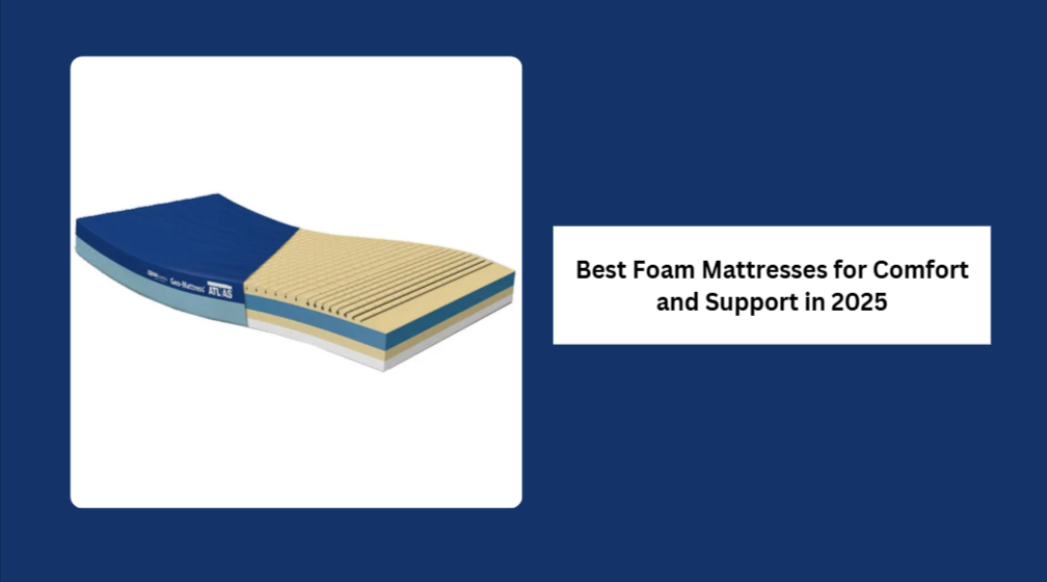In the world of sleep, comfort and support go hand-in-hand—and foam mattresses continue to be a top choice for American households. Whether you’re upgrading your bedroom or looking for a reliable option for a guest room or hospital setup, foam mattresses offer a perfect balance of softness, stability, and affordability.
In this 2025 guide, we’ll explore the best foam mattresses available in the US, covering both traditional polyurethane and advanced memory foam mattresses. We’ll also help you choose the best mattress based on your sleep style, body type, and personal preferences.
What Is a Foam Mattress?
A foam mattress is made entirely of synthetic foam materials, designed to contour the body and relieve pressure points. The most common types include:
- Polyurethane foam (PU foam): Lightweight, firm, and budget-friendly
- Memory foam: Softer, conforms to your body shape
- High-resilience foam: Bouncy and supportive, often used in hybrids
Unlike spring mattresses, foam mattresses have no coils, making them quieter and better at isolating motion—perfect for couples and light sleepers.
Benefits of Foam Mattresses
Here’s why foam mattresses remain a best-seller in 2025:
- Pressure Relief: Foam cushions hips, shoulders, and joints
- Spinal Alignment: Supports the natural curve of your back
- Motion Isolation: Less disturbance when a partner moves
- Allergy-Friendly: Resistant to dust mites and mold
- Durability: Quality foam mattresses last 7–10 years
Best Foam Mattress Types for 2025
a) Traditional Polyurethane Foam Mattress
These are the most affordable foam mattresses. They provide firm support and are great for bunk beds, guest rooms, and short-term use.
Best for: Kids, teens, light adults
Pros: Budget-friendly, lightweight
Cons: Less pressure relief, may compress faster
b) Memory Foam Mattress
This is the most popular type of foam mattress in the US. It conforms to your body, absorbs movement, and provides superior comfort.
Best for: Side sleepers, couples, people with joint pain
Pros: Soft, pressure-relieving, motion-isolating
Cons: Can sleep hot unless infused with cooling gel
c) Gel-Infused Foam Mattress
A modern upgrade of memory foam, this type includes cooling gel beads or layers to reduce heat retention.
Best for: Hot sleepers, warm climates
Pros: Cooler sleep, same comfort as memory foam
Cons: Slightly more expensive
Best Foam Mattress Sizes to Choose From
Twin Size Foam Mattress
- Ideal for kids’ rooms, college dorms, and narrow spaces
- Works well with adjustable hospital-style beds
Full Size Foam Mattress
- Great for single sleepers who want more space
- Also used in guest rooms and smaller apartments
Queen Size Foam Mattress
- The most popular size in the US
- Offers balance between size and affordability
King Size Foam Mattress
- Maximum space and comfort for couples or co-sleepers
- Also available in California King for taller people
Foam Mattress vs. Memory Foam: What’s the Difference?
Many people confuse foam mattresses with memory foam mattresses. Here’s the breakdown:
| Feature | Foam Mattress | Memory Foam Mattress |
| Material | Polyurethane | Viscoelastic polyurethane |
| Comfort | Firm to medium | Soft to plush |
| Body Contouring | Moderate | Excellent |
| Cost | Lower | Higher |
| Best For | Budget buyers | Comfort seekers |
If you’re looking for full-body comfort and pressure relief, memory foam is usually the better option. But for those needing firm support and affordability, traditional foam is a great pick.
Best Foam Mattresses for Back, Side, and Stomach Sleepers
- Back Sleepers: Medium-firm foam mattress supports the spine and prevents sagging.
- Side Sleepers: Memory foam works best to cushion hips and shoulders.
- Stomach Sleepers: Firmer foam helps keep the body aligned and prevents lower back pain.
Foam Mattresses for Medical and Hospital Use
Foam mattresses are widely used in hospital beds and homecare settings. They offer support, ease of cleaning, and pressure relief.
Why foam is ideal for hospitals:
- Easy to disinfect
- Lightweight and easy to transfer
- Suitable for adjustable bed frames
- Works with hospital bed mattress size specifications
Pro Tip: Some hospital bed mattress options combine foam with air cells for added pressure relief.
Top Features to Look for in the Best Foam Mattress
- CertiPUR-US® Certified Foam: Safe, non-toxic, and eco-friendly
- Zoned Support Layers: Different firmness levels for head, torso, and legs
- Cooling Layers: Gel or open-cell foam to improve airflow
- Removable Covers: Easy to wash and maintain
- Warranty and Trial: At least 10 years and a 100-night sleep trial
Where to Buy Foam Mattresses in the USA (2025 Edition)
You can buy top-rated foam mattresses online and in-store at:
- Amazon – Great for reviews, free shipping, and competitive pricing
- Walmart – Wide variety at affordable prices
- Costco/Sam’s Club – Trusted brands with solid return policies
- Mattress Firm – Try before you buy
- Direct Brands – Zinus, Casper, Nectar, Tuft & Needle, and more
Caring for Your Foam Mattress
To get the best lifespan out of your mattress:
- Rotate every 3–6 months to prevent sagging
- Use a breathable protector to guard against spills and allergens
- Keep on a solid foundation for support
- Avoid bending or folding unless it’s designed for adjustable frames
Conclusion
If you’re searching for a balance of comfort, support, and value, foam mattresses remain one of the best investments for sleep in 2025. Whether it’s a basic foam mattress for occasional use or a premium memory foam mattress for nightly rest, there’s an option to match every budget and body type.
From twin to king size memory foam mattresses, today’s foam technology offers better cooling, support, and pressure relief than ever before. Perfect for homes, guest rooms, or even hospital beds, a good foam mattress can make all the difference in sleep quality and overall health.
